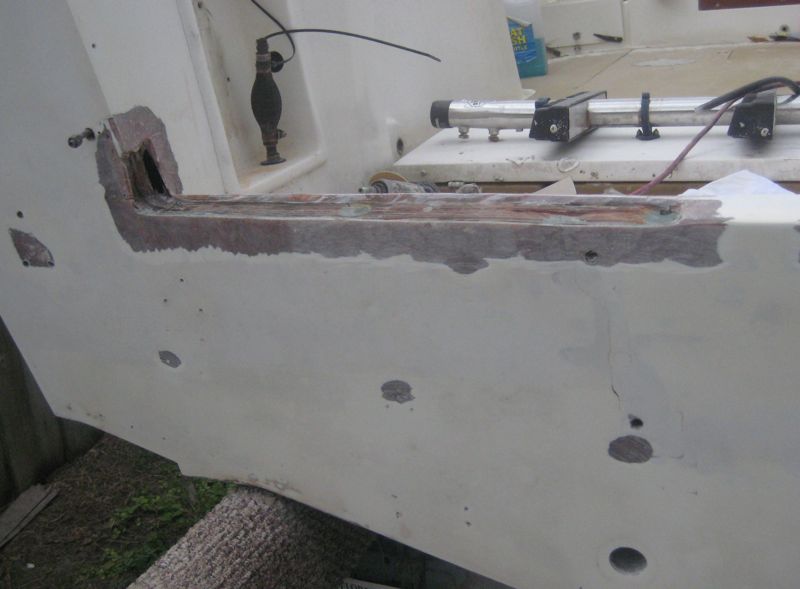The Frustrating Dilemma: Encountering Gelcoat Spider Cracks
As an avid boat enthusiast, I’ve sailed through tranquil waters and navigated challenging storms. Yet, one recurring issue that has tested my patience is the dreaded spider cracks that blemish the otherwise pristine gelcoat surface. These fine, branching cracks can compromise the boat’s aesthetics and raise concerns about structural integrity.

Image: maupoc.weebly.com
Understanding Gelcoat: The Protective Barrier
Gelcoat serves as the vital outermost layer of fiberglass boats, shielding the underlying laminate from the harsh marine environment. Its composition of catalyzed polyester resin and color pigment provides a durable, water-resistant, and UV-resistant barrier. However, over time and with exposure to stress factors, gelcoat can develop spider cracks.
Causes and Consequences of Spider Cracks
Spider cracks typically arise from a combination of fattori:
- Environmental Stress: Temperature fluctuations, impact, and vibrational forces can cause gelcoat to expand or contract unevenly.
- Fiber Glass Stress: Improper installation or a lack of proper reinforcement can result in undue stress on the gelcoat.
- Chemical Exposure: Aggressive cleaning agents or acidic substances may weaken the gelcoat’s surface.
- Aging and Degradation: Prolonged UV exposure and water absorption can deteriorate the gelcoat’s molecular structure.
Left unattended, spider cracks can allow moisture to penetrate the laminate, potentially leading to more severe damage, such as blisters and delamination.
Repairing Spider Cracks: A Step-by-Step Guide
To effectively repair spider cracks, meticulous attention to detail and the right materials are crucial. Here’s a comprehensive guide:
- Cleaning: Thoroughly clean the affected area with a mild detergent and water to remove dirt, grime, and salt crystals.
- Sanding: Using fine-grit sandpaper (400-600 grit), lightly sand the crack’s edges to create a smooth transition and improve adhesion.
- Mixing the Repair Material: Prepare a small batch of marine-grade gelcoat repair compound according to the manufacturer’s instructions.
- Applying the Repair Material: Using a thin brush or applicator, carefully fill the cracks with the repair material, ensuring it penetrates the full depth.
- Leveling and Curing: Smooth the repair material using a putty knife or credit card to create a level surface. Allow the repair material to cure completely as per the manufacturer’s recommendations.
- Sanding and Polishing: Once the repair material has cured, sand the repaired area with fine-grit sandpaper (800-1200 grit) to level it with the surrounding gelcoat. Polish the area to restore its luster.

Image: www.youtube.com
Expert Tips for Optimal Results
- Use High-Quality Materials: Invest in marine-grade gelcoat repair compounds specifically designed for boat repair.
- Follow Manufacturer’s Instructions: Adhere strictly to the repair material manufacturer’s instructions for mixing and application.
- Temperature Considerations: Ensure proper working temperatures during the repair process to promote optimal curing of the repair material.
- Ventilation: Work in a well-ventilated area to minimize exposure to gelcoat fumes.
- Protect Surrounding Areas: Mask off and protect surrounding areas from sanding dust and polishing compounds.
- Patience is Key: Allow ample time for each step, especially curing, to ensure a durable and long-lasting repair.
Frequently Asked Questions
- Can spider cracks affect the boat’s structural integrity?
While spider cracks typically do not compromise the boat’s structural integrity, they can allow moisture to penetrate the laminate, potentially leading to more severe issues. - How can I prevent spider cracks from occurring?
Proper care, maintenance, and reinforcing high-stress areas can minimize the likelihood of spider cracks. - Can I repair spider cracks myself?
With the right materials and by following the proper steps, individuals can repair spider cracks themselves. However, for extensive or complex repairs, it is advisable to consult a professional boat repair specialist.
How To Fix Gelcoat Spider Cracks
Conclusion
Fixing gelcoat spider cracks requires careful preparation, the right materials, and meticulous execution. By following the steps outlined in this guide and incorporating the expert tips, boat owners can effectively restore the integrity and aesthetics of their gelcoat surfaces. If you find yourself facing the challenge of gelcoat spider cracks, embrace it as an opportunity to learn, grow, and maintain the pristine condition of your beloved boat.